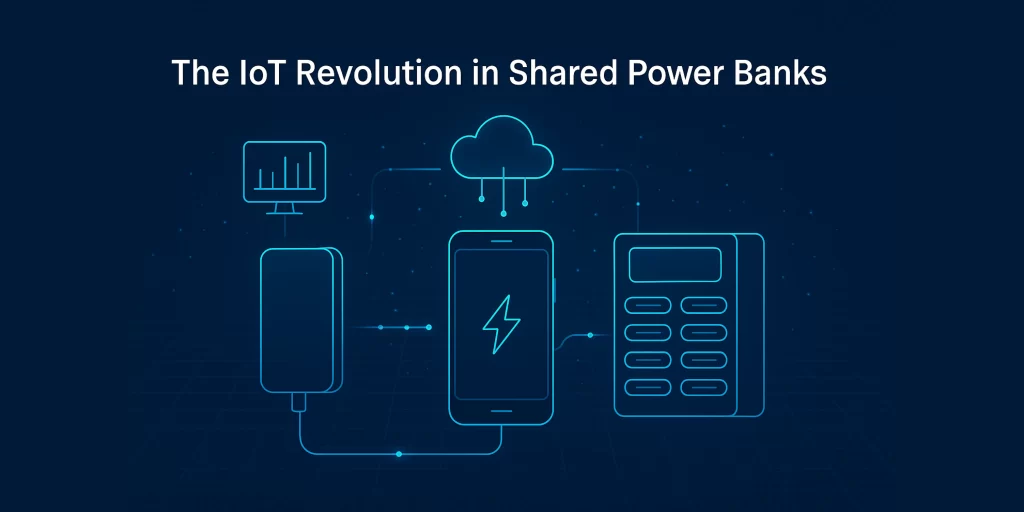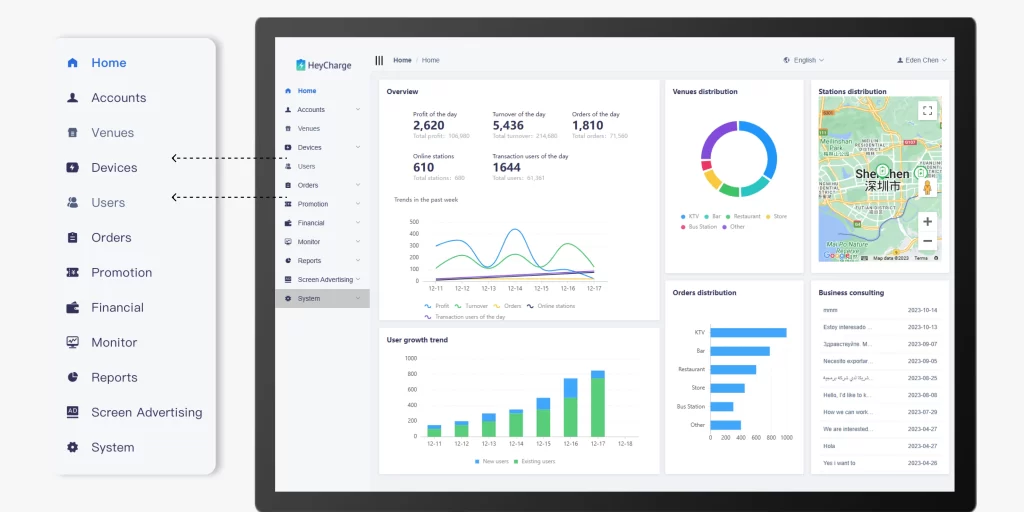
The shared power bank industry is undergoing a technological transformation, driven by the rise of the Internet of Things (IoT). No longer just a simple rental service, IoT-powered shared power banks are reshaping urban infrastructure, optimizing operations, and enhancing user experience. By integrating real-time monitoring, predictive maintenance, and dynamic pricing, businesses can tackle high operational costs and user churn—key pain points that have long hindered industry growth.
Across industries, IoT has already revolutionized asset management, from Tesla’s smart demand balancing to predictive maintenance on offshore oil platforms. What lessons can the shared power bank industry learn? How can operators leverage IoT to maximize efficiency, profitability, and customer satisfaction? In this article, we’ll explore cutting-edge IoT strategies and HeyCharge’s vision for the future of connected charging solutions.
Table of Contents
Part 1. IoT Strategies Across Industries: Lessons for Shared Power Banks
We can learn from successful IoT implementations across industries to enhance the efficiency, profitability, and user experience of shared power banks:
Case 1: Dynamic Demand Balancing – Tesla’s Supercharger Network
Challenge: Overloaded grids and congested stations during peak hours led to a 40% user drop-off rate.
IoT Solution:
- Deployed load sensors and occupancy detectors across stations.
- Algorithm dynamically adjusted pricing: 22% fee hikes during peak demand (weekday evenings), 15% discounts at low-traffic locations.
- Integrated with regional energy grids to prioritize renewable energy use.
Results:
- 34% higher revenue per station.
- 90% charger availability during rush hours (vs. 65% previously).
Implications for Shared Power Banks:
By leveraging smart pricing and demand-based adjustments, shared power banks can optimize utilization, increase revenue, and improve availability in high-traffic areas such as airports, shopping malls, and transit hubs.
Case 2: Predictive Maintenance – Racing Against Time on Offshore Oil Platforms
Challenge: The oil and gas industry experiences an average of 27 days of unplanned downtime per year, resulting in $38 million in losses (Birlasoft).
IoT Solution:
- Installed vibration and corrosion sensors on pumps and compressors for real-time monitoring.
- LSTM neural networks analyzed over 10 years of maintenance logs to predict failures 14 days in advance.
- Edge computing prioritized critical alerts (e.g., overheating) over non-essential data to optimize response time.
Results:
- Reduced financial losses from unexpected equipment failures and minimized unnecessary manual inspections.
- Improved worker safety by preventing hazardous equipment malfunctions.
- Increased annual oil production by approximately 500,000 barrels.
Implications for Shared Power Banks:
IoT-enabled predictive maintenance can minimize operational disruptions, reducing rental failures and customer complaints. Additionally, by tracking charge cycles and proactively replacing aging batteries, operators can lower costs and enhance service reliability.
Case 3: Frictionless Experience – Shell Recharge’s App Ecosystem
Challenge: Complex payment steps and inactive chargers led to 25% user churn.
IoT Solution:
- Live status updates (availability and power level) mapped via GPS.
- One-tap payments with auto-renew subscriptions.
- Loyalty tiers offering free charges after 10 uses and partner rewards (e.g., Starbucks discounts).
Results:
- 18% increase in monthly active users.
- 40% faster checkout times.
Implications for Shared Power Banks:
Enhancing user experience with seamless app-based reservations, real-time availability tracking, and gamified incentives can drive user engagement and retention.
By integrating these IoT strategies, shared power banks can enhance operational efficiency, increase revenue, and provide a superior user experience in an increasingly competitive landscape.
Part 2. IoT Integration Roadmap: From Basics to Ecosystem
Successful IoT integration is a phased journey, evolving from basic monitoring to intelligent automation and sustainability. In the shared power bank industry, leveraging IoT-driven strategies enhances operational efficiency, optimizes revenue models, and expands business potential.
Stage 1: Real-Time Monitoring (Current Capability)
The foundation of IoT adoption lies in improving operational visibility and rapid response times. By integrating GPS and battery sensors, operators can optimize replenishment routes and receive malfunction alerts within two minutes. For example:
- Device Malfunction Detection: Systems automatically flag cases where a rented power bank fails to eject, allowing for faster intervention.
- Heatmap-Based Deployment: Demand analysis helps optimize station density in high-traffic locations like shopping malls and transit hubs.

Stage 2: Data-Driven Optimization (Next Phase)
Advanced analytics and AI-driven decision-making will further refine efficiency and profitability:
- Dynamic Pricing Algorithms: Adjust rental rates based on foot traffic. At Tokyo’s Shibuya Station, ChargeSPOT increased revenue by 25% by raising the 3-hour rental fee to 360 yen during peak hours.
- User Behavior Analytics: By tracking peak usage patterns (e.g., 30-minute sessions in Japan), operators can implement targeted promotions such as off-peak discounts, boosting repurchase rates by 15%
- Predictive Maintenance: AI-driven diagnostics can forecast battery degradation based on charge cycle data, enabling proactive replacements and reducing downtime.
Stage 3: Intelligent Automation & Sustainability (Future Vision)
The future of IoT-powered shared power banks extends beyond operational efficiency, integrating sustainability and automation:
- AI-Powered Inventory Balancing: Machine learning models can predict demand shifts and dynamically redistribute power banks before shortages occur, reducing operator intervention.
- Autonomous Charging & Servicing Stations: Inspired by automated retail kiosks, future charging stations could feature self-cleaning, auto-repair mechanisms, and modular battery swaps to reduce on-site maintenance.
- Sustainable Energy Solutions: Incorporating solar-powered charging stations can significantly cut grid dependency. Inspired by DBS Bank’s solar charging model, this could reduce energy costs by 40% in tropical regions.
By progressing through these IoT integration stages, the shared power bank industry can evolve into a smarter, self-sustaining, and highly efficient ecosystem.
Part 3. Our Journey: IoT-Driven Innovation at HeyCharge
At HeyCharge, we leverage IoT-driven solutions to enhance the shared power bank industry by seamlessly connecting hardware, software, and users. From concept to implementation, we focus on innovation, efficiency, and user-friendly technology to create a smarter charging network.
Our advanced management system enables operators—whether agents, merchants, or partners—to effortlessly oversee device deployments, monitor real-time performance, and optimize revenue streams. By integrating IoT technology, HeyCharge provides a smart ecosystem where power banks are tracked remotely, charging stations are managed with ease, and transaction data is synchronized in real-time.
Through our robust platform, businesses can analyze customer usage patterns, adjust rental strategies, and ensure seamless operations with automated device monitoring. With features like role-based access control, multilingual support, and insightful analytics, HeyCharge empowers global operators to scale their charging networks efficiently.
As we continue to expand, our mission remains clear: to provide an intelligent, connected, and reliable power bank rental system that enhances user convenience while maximizing business potential.
Ready to take your shared power bank business to the next level? Click the button below to contact us and explore how HeyCharge can help you grow!



